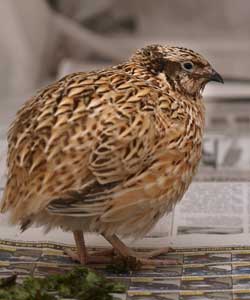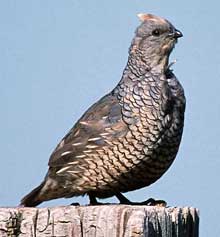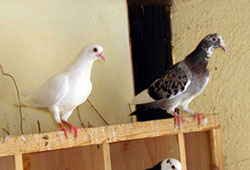
(Image Courtesy of Ingrid Taylar)
The Coturnix Quail, also known as Japanese Quail (Coturnix japonica), is a species of Old World quail found in East Asia. They are a migratory species, breeding in Manchuria, southeastern Siberia, northern Japan, and the Korean Peninsula, and wintering in the south of Japan and southern China. They dwell in grasslands and cultivated fields. The plumage of the pharaoh Japanese quail breed is a speckled yellow-brown, with a creamy white strip above the eye. Adults are about 20 cm (7.9 in) in length. The species is abundant across most of its range. Currently there are a few true breeding mutations of the Japanese quail, the breeds from the United States are: Texas A&M, English White, Golden Range, Red Range, Italian, Manchurian, Tibetan, Rosetta, Scarlett, Roux Dilute and Golden Tuxedo.
Coturnix quail have been reared in India and Southeast Asia for their meat and eggs. The species is seen as a good “dual-purpose bird”. In India, Krishi Vigyan Kendra Kannur under Kerala Agricultural University has produced video album containing songs and visuals on Japanese quail production under Creative Extension series.
Japanese quail eggs have orbited the Earth in several Soviet and Russian spacecraft, including the Bion 5 satellite and the Salyut 6 and Mir space stations. In March 1990 eggs on Mir were successfully incubated and hatched.

The Scaled Quail (Callipepla squamata), also commonly called Blue Quail or Cottontop, is a species of the New World quail family. It is a bluish gray bird found in the arid regions of the Southwestern United States to Central Mexico. This species is an early offshoot of the genus Callipepla, diverging in the Pliocene.
This bird is named for the scaly appearance of its breast and back feathers. Along with its scaly markings, the bird is easily identified by its white crest that resembles a tuft of cotton.
Scaled Quail inhabit dry, open valleys, plains, foothills, rocky slopes, draws, gullies, and canyons that have a mixture of bare ground, low herbaceous growth, and scattered brushy cover. Good Scaled Quail habitat is characterized by low-growing grasses with forbs and shrubs. Overall ground cover is between 10 and 50%. Trees and shrubs should be less than 6.6 feet (2 m) tall. Scaled Quail avoid the dense growth associated with streamsides. Transmitter-fitted Scaled Quail had individual home range sizes of 52 and 60 acres.
The nest is typically a grass-lined hollow containing 9–16 speckled eggs. When disturbed, it prefers to run rather than fly. Widespread and common throughout its range, the Scaled Quail is evaluated as Least Concern on the IUCN Red List of Threatened Species.
The Rock Dove (Columba livia) or rock pigeon is a member of the bird family Columbidae (doves and pigeons). In common usage, this bird is often simply referred to as the “Pigeon”.
The species includes the domestic pigeon (including the fancy pigeon), and escaped domestic pigeons have given rise to feral populations around the world.
 Wild Rock Doves are pale grey with two black bars on each wing, while domestic and feral pigeons are very variable in color and pattern. There are few visible differences between males and females. The species is generally monogamous, with two squabs (young) per brood. Both parents care for the young for a time.
Wild Rock Doves are pale grey with two black bars on each wing, while domestic and feral pigeons are very variable in color and pattern. There are few visible differences between males and females. The species is generally monogamous, with two squabs (young) per brood. Both parents care for the young for a time.
Habitats include various open and semi-open environments. Cliffs and rock ledges are used for roosting and breeding in the wild. Originally found wild in Europe, North Africa, and western Asia, pigeons have become established in cities around the world. The species is abundant, with an estimated population of 17 to 28 million feral and wild birds in Europe.
The adult of the nominate subspecies of the rock dove is 29 to 37 cm (11 to 15 in) long with a 62 to 72 cm (24 to 28 in) wingspan. Weight for wild or feral rock doves ranges from 238–380 g (8.4–13.4 Oz), though overfed domestic and semi-domestic individuals can exceed normal weights. It has a dark bluish-grey head, neck, and chest with glossy yellowish, greenish, and reddish-purple iridescence along its neck and wing feathers. The iris is orange, red or golden with a paler inner ring, and the bare skin round the eye is bluish-grey. The bill is grey-black with a conspicuous off-white cere, and the feet are purplish-red. Among standard measurements, the wing chord is typically around 22.3 cm (8.8 in), the tail is 9.5 to 11 cm (3.7 to 4.3 in), the bill is around 1.8 cm (0.71 in) and the tarsus is 2.6 to 3.5 cm (1.0 to 1.4 in).
The adult female is almost identical to the male, but the iridescence on the neck is less intense and more restricted to the rear and sides, while that on the breast is often very obscure.
The white lower back of the pure rock dove is its best identification character; the two black bars on its pale grey wings are also distinctive. The tail has a black band on the end and the outer web of the tail feathers are margined with white. It is strong and quick on the wing, dashing out from sea caves, flying low over the water, its lighter grey rump showing well from above.
Young birds show little lustre and are duller. Eye color of the pigeon is generally orange but a few pigeons may have white-grey eyes. The eyelids are orange in color and are encapsulated in a grey-white eye ring. The feet are red to pink.
Use Our Game Bird Inquiry Form
Wings Over Colorado LLC
Phone: (720) 425-8968
Email @ rob@wingsovercolorado.com
Copyright © 2012 Wings Over Colorado. All Rights Reserved. Top ↑